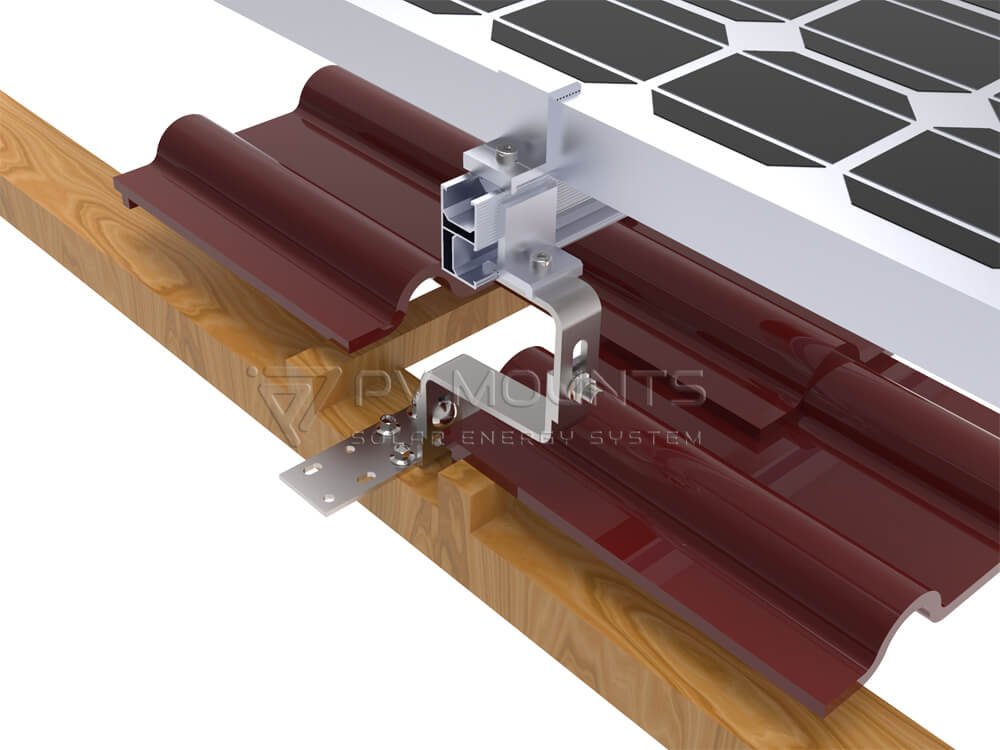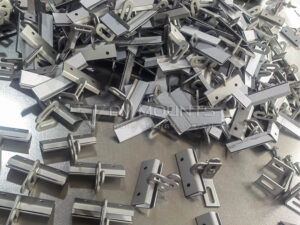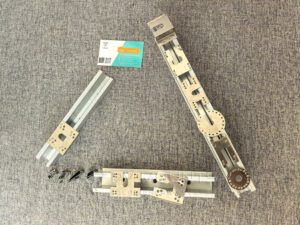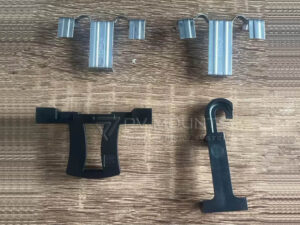No crescente campo da energia solar, a fixação de painéis fotovoltaicos em telhados de forma eficiente e segura é fundamental. Entre a miríade de componentes que contribuem para uma instalação solar robusta, os ganchos para telhas solares se destacam por seu papel fundamental. Essas peças pequenas, porém robustas, são projetadas para ancorar os painéis solares nas telhas, garantindo que a instalação resista às tensões ambientais e otimize a captação de energia.
Índice
Introdução aos ganchos para telhas solares
A energia solar revolucionou a forma como pensamos sobre a geração de energia, mas a eficácia dos painéis solares é muito influenciada pela forma como são instalados. Um componente fundamental no processo de instalação é o gancho para telhas solares, que serve como interface entre o painel solar e as telhas do telhado. Esses ganchos não são apenas funcionais - eles são feitos sob medida para atender às diversas necessidades de vários materiais e estilos de telhado, o que os torna indispensáveis na busca por energia renovável.
A importância dos ganchos para telhados de telhas solares deve ser abordada; eles são os pontos principais de toda a instalação. Ao garantir a estabilidade e a durabilidade dos painéis solares, esses ganchos ajudam a manter a integridade do painel solar e do próprio telhado. À medida que nos aprofundamos em seus tipos, usos e processos de instalação, fica claro que um gancho para telhado de telha solar bem escolhido não só aumenta a longevidade da instalação solar, mas também sua eficiência e segurança.
Entendendo os conceitos básicos
O que são ganchos para telhas solares?
Ganchos para telhas solares são dispositivos especializados projetados para fixar com segurança os painéis solares nos telhados de residências e edifícios. Esses ganchos são essenciais nos sistemas de montagem, pois precisam suportar cargas ambientais significativas, incluindo vento, chuva e o peso dos próprios painéis solares. O design dos ganchos para telhas solares varia significativamente, dependendo do tipo de telha que eles devem suportar, desde telhas planas até telhas espanholas, cada uma exigindo um formato e um material específicos para funcionar com eficiência.
Materiais utilizados
Os materiais usados na fabricação de ganchos para telhados de telhas solares são selecionados com base em sua durabilidade e resistência a fatores ambientais. Aço inoxidável e alumínio são as opções mais comuns, valorizadas por sua resistência e propriedades anticorrosivas. Esses materiais garantem que os ganchos possam suportar a exposição de longo prazo a diversas condições climáticas sem degradação, protegendo assim o investimento em tecnologia solar. A escolha do material também afeta o processo de instalação e o custo geral do sistema de montagem solar, o que o torna uma consideração essencial tanto para os fabricantes quanto para os instaladores.
Tipos de ganchos para telhado de telha solar
A variedade de materiais e estilos de telhado exige diferentes tipos de ganchos para telhas solares. Cada tipo é projetado para atender a condições arquitetônicas e climáticas específicas, garantindo que os painéis solares sejam instalados de forma segura e eficiente.
Ganchos para telhado de telha plana
Os ganchos para telhas planas são projetados para residências modernas com telhas planas de concreto ou ardósia. Esses ganchos mantêm um perfil baixo e são projetados para se ajustarem confortavelmente ao material da cobertura, minimizando qualquer impacto na estética visual do telhado.
Ganchos para telhado de telha espanhola
Para casas com telhas de barro espanholas tradicionais, são necessários ganchos especializados. Esses ganchos geralmente são em forma de S ou têm um contorno que combina com a forma ondulada dos azulejos. Esse design garante que o gancho se encaixe perfeitamente no formato do azulejo, proporcionando uma montagem segura sem interromper o alinhamento do azulejo.
Ganchos de teto em forma de S
Os ganchos em forma de S são versáteis e podem ser usados com vários tipos de telhas. Seu formato exclusivo permite que eles se enganchem com segurança sobre a telha, fornecendo uma base estável para o painel solar. Esses ganchos são particularmente úteis em regiões com condições de muito vento, pois seu formato proporciona mais aderência e estabilidade.
Escolhendo o gancho certo para telhas
A seleção do gancho para telha solar adequado é mais do que uma simples escolha técnica; trata-se de garantir a longevidade e a eficiência de sua instalação solar. O processo de seleção é influenciado por vários fatores, cada um dos quais deve ser cuidadosamente considerado para garantir que os painéis solares tenham o melhor desempenho possível durante sua vida útil operacional.
Fatores a serem considerados
Ao escolher um gancho para telha solar, vários fatores críticos entram em jogo:
- Tipo de telhado: O tipo de telha determina o estilo de gancho necessário. Por exemplo, os telhados planos podem precisar de ganchos diferentes em comparação com os telhados inclinados com telhas espanholas.
- Compatibilidade de materiais: O material do teto e dos ganchos deve ser compatível para evitar a corrosão eletroquímica, que pode enfraquecer a estrutura com o tempo.
- Capacidade de suporte de carga: É fundamental considerar a carga ambiental (vento, neve, chuva) que os ganchos e a estrutura do telhado precisarão suportar.
- Estética: Para muitos proprietários de imóveis, os ganchos devem manter o apelo visual da propriedade. Estão disponíveis ganchos de baixo perfil que minimizam a visibilidade.
Problemas de compatibilidade
Ganchos e telhas incompatíveis podem levar a instalações inadequadas, podendo causar danos estruturais ou ineficiências no sistema de painéis solares. Garantir a compatibilidade envolve não apenas o ajuste físico, mas também a capacidade do gancho de se integrar perfeitamente ao material de cobertura existente sem causar danos ao longo do tempo.
Instalação de ganchos para telhado de telha solar
A instalação correta dos ganchos para telhado de telha solar é fundamental para o sucesso e a durabilidade do sistema de painéis solares. A instalação incorreta pode levar a falhas no sistema, diminuição da produção de energia e até mesmo riscos à segurança.
Guia passo a passo
- Inspeção e planejamento: Antes de iniciar qualquer trabalho, inspecione o telhado para garantir que ele esteja em boas condições e seja adequado para a instalação solar. Planeje o layout dos painéis e ganchos para otimizar a exposição à luz solar.
- Posicionamento dos ganchos: Posicione os ganchos de acordo com o layout planejado. A precisão aqui é crucial para garantir que os painéis sejam alinhados corretamente.
- Protegendo os ganchos: Fixe os ganchos no teto usando as ferramentas e os fixadores apropriados. Certifique-se de que cada gancho esteja bem preso e estável.
- Montagem dos painéis: Quando os ganchos estiverem no lugar, os painéis solares poderão ser montados neles. Certifique-se de que cada painel esteja preso com segurança e corretamente alinhado.
Erros comuns
Erros comuns de instalação incluem:
- Apertar demais os fixadores, o que pode rachar os azulejos.
- O aperto insuficiente pode fazer com que os painéis se soltem.
- Espaçamento incorreto dos ganchos, afetando a distribuição da carga e a estabilidade do painel.
Benefícios da seleção ideal do gancho
Escolher o gancho para telha solar certo e instalá-lo corretamente traz vários benefícios:
Ganhos de eficiência
Os ganchos para telhas solares instalados corretamente garantem que os painéis sejam posicionados de forma ideal para a exposição máxima à luz solar. Esse alinhamento afeta diretamente a eficiência do sistema solar, pois mais luz solar significa mais energia gerada.
Longevidade dos painéis solares
Os ganchos seguros e estáveis evitam que os painéis se movam, o que reduz o desgaste. Essa estabilidade prolonga a vida útil dos painéis solares e reduz a necessidade de reparos ou substituições dispendiosas.
Desafios e soluções
A jornada de instalação de ganchos para telhas solares tem seus desafios. Compreender esses desafios e preparar-se para eles pode facilitar significativamente o processo de instalação e aumentar a longevidade e a eficiência dos painéis solares.
Superação de problemas comuns
Alguns desafios frequentes incluem:
- Danos aos ladrilhos: A instalação incorreta pode causar rachaduras nos azulejos. O uso das ferramentas e técnicas corretas, como furar com cuidado e usar materiais de amortecimento adequados, pode evitar isso.
- Condições climáticas: Condições climáticas extremas podem testar a durabilidade dos ganchos. A escolha de materiais como aço inoxidável ou alumínio anodizado, que podem resistir a condições climáticas adversas, é fundamental.
- Layouts de telhados complexos: Telhados com formatos incomuns ou vários níveis podem exigir ganchos projetados sob medida ou técnicas especiais de instalação para garantir um encaixe seguro.
Dicas de especialistas
- Consulte um profissional: Em caso de dúvida, a consulta a um instalador profissional pode evitar muitos erros comuns de instalação.
- Inspeções regulares: Após a instalação, as inspeções regulares ajudam a detectar e corrigir quaisquer problemas antes que eles se agravem.
- Mantenha-se informado: Manter-se atualizado com os materiais e as técnicas de instalação mais recentes pode resultar em instalações mais duráveis e eficientes.
Dicas de manutenção
A manutenção adequada dos ganchos de telhas solares é essencial para garantir o sucesso e a eficiência de longo prazo de um sistema de painéis solares.
Verificações regulares
É fundamental verificar periodicamente se há sinais de desgaste ou danos nos ganchos. Isso inclui procurar ferrugem, componentes soltos ou qualquer sinal de que os ganchos estejam se soltando do teto.
Quando substituir
Se algum sinal de deterioração for detectado durante as inspeções, a substituição dos ganchos o quanto antes pode evitar mais danos aos painéis solares e ao telhado. Também é aconselhável considerar a vida útil recomendada pelo fabricante para os ganchos. Ela pode servir como diretriz para os intervalos de substituição.
Tendências futuras em montagem de painéis solares
Com o avanço da tecnologia, o mesmo acontece com os métodos e materiais usados nos sistemas de montagem solar. Manter-se à frente dessas tendências é benéfico para qualquer pessoa envolvida em instalações solares.
Inovações no horizonte
As tecnologias emergentes incluem projetos de ganchos mais adaptáveis e fáceis de instalar para uma variedade maior de telhas e condições. Além disso, há um movimento em direção a materiais mais sustentáveis, que são mais leves e mais resistentes.
Materiais sustentáveis
A mudança para processos de fabricação mais ecológicos e o uso de materiais reciclados ou ecologicamente corretos na produção de ganchos solares refletem a tendência geral do setor em relação à sustentabilidade.
Conclusão
Os ganchos para telhas solares desempenham um papel fundamental na instalação eficaz e eficiente dos painéis solares. A escolha dos ganchos corretos, a garantia da instalação adequada e a boa manutenção são fundamentais para aproveitar ao máximo os benefícios de seu sistema de energia solar. No futuro, o avanço do setor em direção a soluções inovadoras e sustentáveis promete melhorar a acessibilidade e a eficácia dos sistemas de energia solar, tornando-os uma escolha inteligente para consumidores ambientalmente conscientes que buscam reduzir sua pegada de carbono e os custos de energia.
Perguntas frequentes
Qual é o melhor material para ganchos de telhas solares em áreas costeiras?
Nas áreas costeiras, os melhores materiais para ganchos de telha solar são aqueles que oferecem excelente resistência à corrosão causada por água salgada e condições de umidade. O aço inoxidável, especialmente os graus 316 ou 304, é altamente recomendado devido à sua resistência superior à ferrugem. Outra boa opção é o alumínio, que também tem bom desempenho contra a corrosão, desde que seja adequadamente revestido ou anodizado.
Como o peso dos painéis solares afeta a escolha dos ganchos?
O peso dos painéis solares influencia diretamente o tipo e a resistência dos ganchos necessários. Painéis mais pesados exigem ganchos com maior capacidade de carga para garantir estabilidade e segurança. É essencial escolher ganchos que possam não apenas suportar o peso dos painéis, mas também suportar cargas adicionais de vento, neve ou outros fatores ambientais.
Quais são as últimas inovações na tecnologia de ganchos para telhas solares?
As inovações recentes na tecnologia de ganchos para telhas solares incluem ganchos ajustáveis e autonivelantes que podem se adaptar a diferentes inclinações de telhado e tipos de telhas, facilitando instalações mais fáceis e seguras. Há também uma tendência de sistemas integrados de ganchos e flashes que melhoram a impermeabilização e reduzem o tempo de instalação. Além disso, os fabricantes estão desenvolvendo materiais compostos mais leves e resistentes que aumentam a durabilidade e são ecologicamente corretos.
Os ganchos para telhas solares podem ser instalados em todos os tipos de telhas?
Os ganchos para telhas solares são versáteis, mas apenas alguns ganchos são adequados para alguns tipos de telhas. Diferentes designs são feitos sob medida para perfis específicos de telhas, como telhas planas, espanholas ou em forma de S. É fundamental selecionar um gancho que corresponda ao tipo e ao formato específicos da telha para garantir um encaixe seguro e evitar danos às telhas.
O que devo fazer se notar ferrugem nos ganchos da minha telha solar?
Se for observada ferrugem nos ganchos da telha solar, é importante avaliar a extensão da corrosão. A ferrugem menor geralmente pode ser limpa e tratada com inibidores de ferrugem para prolongar a vida útil dos ganchos. No entanto, se a ferrugem for significativa, ela poderá comprometer a integridade estrutural dos ganchos, e substituí-los seria a opção mais segura. A manutenção regular e o uso de materiais resistentes à corrosão desde o início podem evitar o desenvolvimento de ferrugem.
Com que frequência devo realizar verificações de manutenção em minha instalação solar?
Verificações regulares de manutenção são cruciais para garantir a longevidade e a eficiência de sua instalação solar. Recomenda-se fazer uma inspeção visual do seu sistema solar, incluindo os ganchos para telhas, pelo menos uma vez por ano. Além disso, após eventos climáticos severos, como tempestades ou fortes nevascas, devem ser realizadas inspeções adicionais para garantir que a instalação não tenha sido comprometida. As verificações regulares ajudam a identificar possíveis problemas antecipadamente, reduzindo o risco de reparos caros ou perdas de eficiência.













